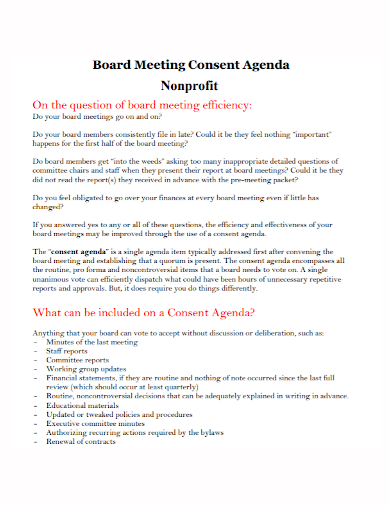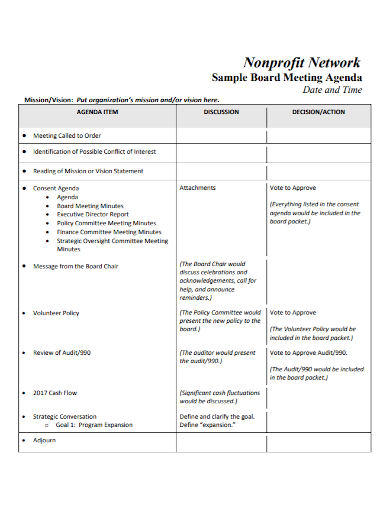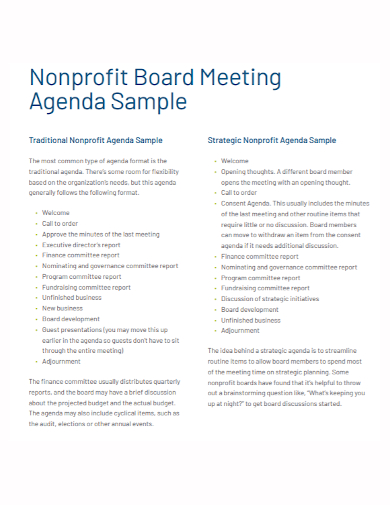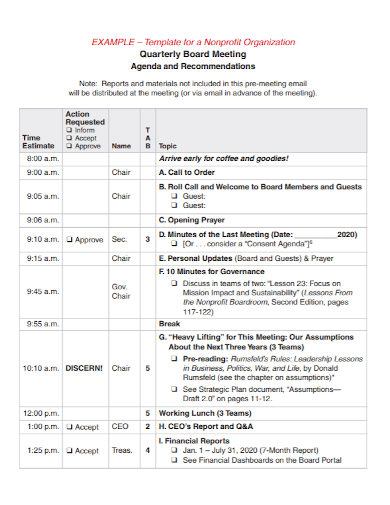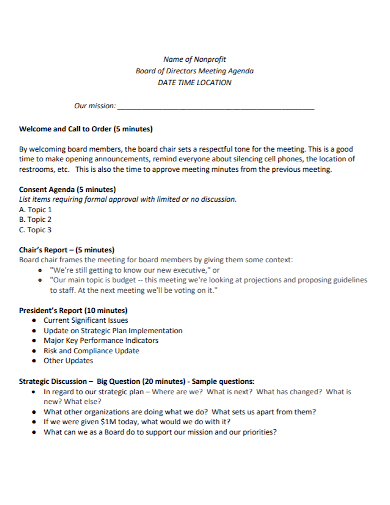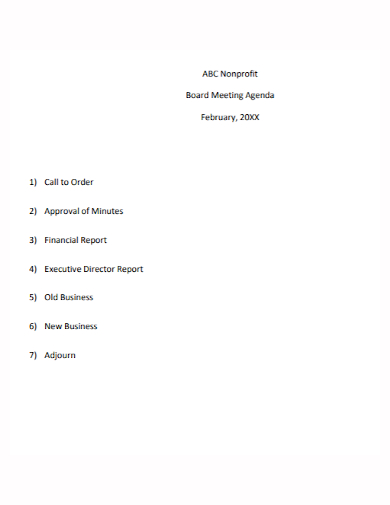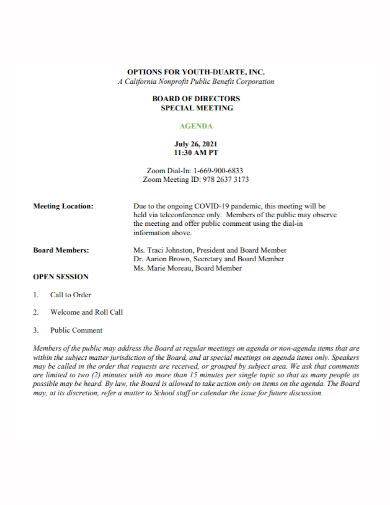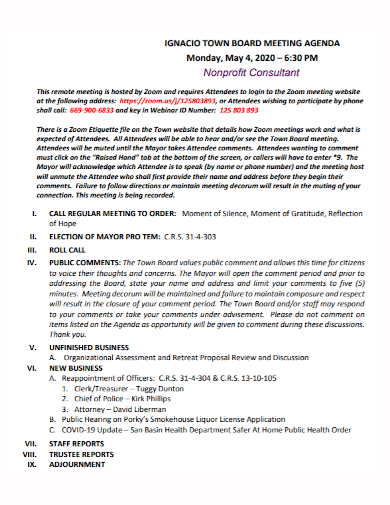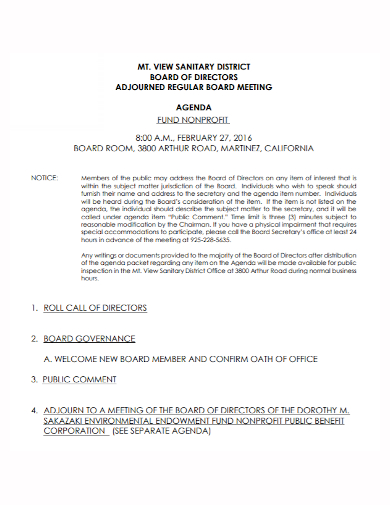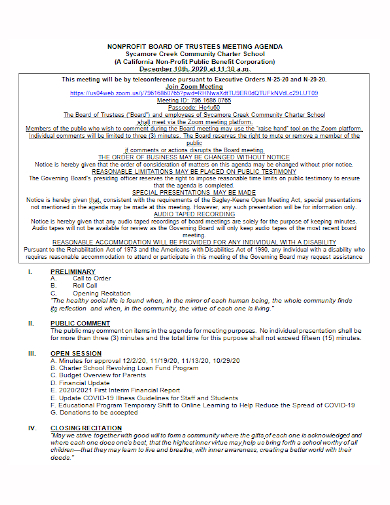Just like any other organization and company, nonprofit organizations also have board members that conduct meetings to discuss developments and strategies. Regardless of whether the nonprofit board members meet quarterly, or monthly, they need a meeting agenda to have an effective flow of their meetings to make it productive. If you’re assigned to make a meeting agenda, this article will help you on how to create one.
10+ Nonprofit Board Meeting Agenda Samples
1. Nonprofit Board Meeting Consent Agenda
2. Nonprofit Network Board Meeting Agenda
3. Nonprofit Board Meeting Agenda
4. Nonprofit Quarterly Board Meeting Agenda
5. Nonprofit Board of Directors Meeting Agenda
6. Sample Nonprofit Board Meeting Agenda
7. Nonprofit Corporation Board Meeting Agenda
8. Nonprofit Board of Directors Special Meeting Agenda
9. Nonprofit Consultant Board Meeting Agenda
10. Nonprofit Regular Board Meeting Agenda
11. Nonprofit Board Trustee Meeting Agenda
What is a Nonprofit Board Meeting?
A nonprofit board meeting is where board members of a nonprofit organization meet periodically to plan for the budget, fundraising activities, events, and elect officers.
Details to Include in a Nonprofit Board Meeting Agenda
In organizations, there are people assigned to plan for the board meeting days before the scheduled meeting. This is to ensure that the board will have a set of topics to be discussed for the meeting agenda so the board members will know what the meeting is all about. Making the agenda is similar to creating meeting minutes. Here is how to create a meeting agenda:
- Attendance: Keep track of the members who are attending the meeting and those who were absent. Ensure that your meeting always starts on time. Starting meetings on time will give you ample time to address all your meeting agendas.
- Introductions: Take a short time to introduce new members and guests attending the meeting. You can skip this step if the meeting only consists of existing board members.
- Minutes from the Previous Meeting: It should be distributed before the meeting starts. This will help everyone remember the agenda that was discussed in the previous meeting and remind all of the agenda that will be discussed at the current meeting.
- Unfinished Business and New Business Reports: This is where the board members receive reports from different committees, discuss pending and new projects, previous or existing assignments, talk about any developments within the board, discuss upcoming events, and address issues internally and externally. Depending on your agenda, all members are asked to give reports based on the committee they belong to. Below are some examples of different committees of the organization and their role in giving reports to the members.
- Executive director’s report: The executive director is in charge of informing the board members of staff changes, donor details, and successful campaign details. The director also relays staff ideas and concerns that need to be considered by the board.
- Finance committee report: This committee show income and expenses current to the organization.
- Other committees such as the governance committee, program committee, and fundraising committee are also tasked to report any updates or projects or assignments that they have.
- Next Meeting and Adjournment: After all the agenda has been discussed and plan the next agenda for the next meeting, it’s time to wrap up the meeting by setting a schedule for the next meeting.
FAQs
What are the risks of not having an agenda for the nonprofit board meeting?
If you fail to create an agenda for every board meeting, the members will never organize the topics or ideas they want to discuss during the meeting and this could result to board meetings being disconnected and disinterested in participating in the meeting. When members are acting like this, your board meeting is likely to be unproductive.
What makes an effective nonprofit board meeting?
A board meeting is deemed as effective if the agenda is prepared way ahead of time and it is concise enough for members to understand the topics they will be discussing, and the meeting begins and ends on time.
What is the purpose of a nonprofit board?
The board of directors makes up the governing body of a nonprofit. They are responsible for overseeing the organization. Part of their duties includes meeting with each other to discuss and vote on the affairs of the organization, work on strategies, setting goals and objectives, overseeing programs and activities, and actively managing risks.
Once the meeting ends, start organizing the discussed agendas right away. Organize these into their correct headings such as putting each discussed agenda over new business or old business. Once you’re done writing your agenda, schedule a time to meet with the board president to go over the agenda and revise it weeks before the next board meeting. If the meeting soon comes up, prepare a notice to remind the members of the upcoming meeting and to let follow up on any tasks discussed from the previous meeting. To help you get started on creating a meeting agenda, download our free sample templates provided above!
Related Posts
FREE 7+ Sample Event Agenda Templates in PDF MS Word
FREE 6+ Event Agenda Samples in PDF
FREE 8+ School Agenda Samples in PDF MS Word
FREE 6+ Student Agenda Samples in MS Word PDF
FREE 11+ Event Agenda Samples & Templates in PDF
FREE 10+ Sample Meeting Agenda Templates in PDF MS Word
FREE 6+ Sample Staff Meeting Agenda Templates in PDF
FREE 10+ Charity Meeting Agenda Samples & Templates in PDF
FREE 10+ Retail Meeting Agenda Samples in PDF MS Word
FREE 9+ Workshop Agenda Samples in PDF
FREE 10+ Retreat Agenda Templates in PDF MS Word
FREE 9+ Sample Conference Agenda Templates in PDF MS Word
FREE 6+ Wedding Agenda Samples in MS Word PDF
FREE 13+ Sales Meeting Agenda Templates in PDF WORD
FREE 7+ Agenda Calendar Templates in PDF

